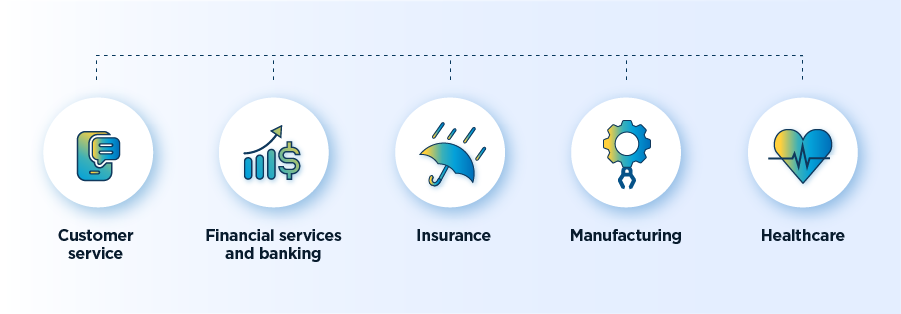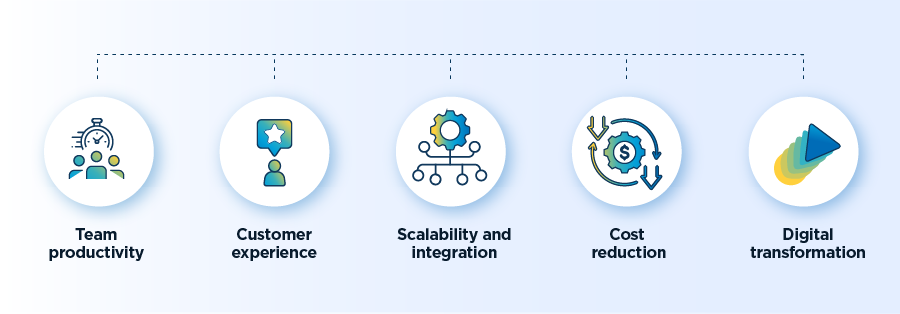Exploring AI and Generative AI Automation

In the modern field of AI-based systems and the current innovations in generative AI, organizations are finding new ways to develop more efficient processes and implement game-changing improvements for years to come.
For many, there’s a fear of how gen AI could impact their employees, customers, and compliance with regulations. In this guide, we’ll look at how artificial intelligence technology can be safely and effectively deployed into your automations and how you can utilize the abilities of language models and other generative AI automation to transform your business.
What Is AI Automation?
Automation began with robots performing repetitive tasks – also called robotic process automation (RPA). As artificial intelligence (AI) evolved, automation’s capabilities have expanded to include end-to-end processes, connecting systems, and orchestrating work. That connection of RPA with AI and business process management (BPM) is called intelligent automation (IA).
RPA | Performs repetitive tasks |
AI | Mimics human thinking |
BPM | Automates workflows |
IA | Combines RPA, AI, and BPM |
Is AI the same as automation?
No, AI isn’t the same as automation — but they can work together to do a lot more than either could manage on its own. That team-up is where you get cognitive automation.
Automation deploys robots to execute a series of rule-based instructions set by humans, reducing the manual labor involved in routine tasks. If the action goes beyond what the developer programmed, the robots are unable to complete the task.
By incorporating AI into RPA and other automation technologies, robots can take the broad outlines laid out by humans and determine their own pathway to achieve the goal. The ML capabilities within AI allow it to learn from its actions so it can improve its performance over time.
Here's how that combination works in a nutshell to create intelligent automation:
- AI uses ML and complex algorithms to analyze structured and unstructured data. It’s the cognitive decision-making side of IA.
- BPM automates workflows and connects people and systems.
- RPA completes simple administrative tasks such as form filling and data extraction.
Artificial intelligence (AI) as a technology can also include machine learning (ML), natural language processing (NLP), computer vision, and deep learning techniques.
What is an example of automation and AI working together?

AI automation technologies (AKA intelligent automation) allow organizations to augment their human workers with these IA digital workers to streamline business processes. This helps deal with skills and labor shortages and frees employees from boring, repetitive tasks so they can focus on higher-value strategic work.
A good example of this is virtual assistants or AI-powered chatbots. Customer service centers are often bombarded with thousands of emails – too many for a few people to respond to adequately and rapidly within their eight-hour workday. However, AI chatbots answer customer queries instantly, working around the clock to reduce customer wait time. If the chatbot can’t answer a customer’s question, the conversation is brought to a human agent. This helps reduce wait times and backlogs and means the employees can focus on more complex cases.
How can you automate more with AI?
By putting automation and AI (or gen AI) together, you can take your business capabilities further:
- Generative AI interprets and creates content with simulated human intelligence, including text and images, to augment work. Using natural language processing, gen AI can answer customer inquiries and augment decision-making. At SS&C Blue Prism, we’re expanding our intelligent automation with generative AI to enable businesses to automate more complex processes.
- Process discovery can use AI to track behavior in real time and extract insights based on that behavior, identifying bottlenecks and opportunities for improvements. After the discovery process, it generates a process map to help your teams develop more automations.
- Intelligent document processing (IDP) uses machine learning (ML) for data processing. IDP can extract and validate data from structured and semi-structured documents such as invoices, purchase orders, and application forms. By implementing gen AI, IDP can move beyond process validation to understand the context and purpose of a document and interpret how that data should be used, bringing you a faster time to market.
Gen AI elevates each stage of the automation development lifecycle, from process discovery to build, ongoing management, and monitoring. SS&C Blue Prism has partnered with AWS to develop secure and private IA solutions that incorporate enterprise-grade generative AI.
How Do I Use AI and Automation?

AI automation has a lot of versatility. It can help organizations improve efficiency, reduce errors, and enhance their decision-making processes. Let’s look at some industry use cases:
What are examples of AI automation?
- Customer service: Let’s say a customer has an issue and they’re looking for an immediate resolution. AI-powered solutions can resolve customer complaints quickly or escalate issues to a service agent for more nuanced cases – ensuring your customers have a streamlined journey to resolution.
- Financial services and banking: IA can digitize the loan process and streamline administrative processes such as know-your-customer (KYC) ID verification and anti-money laundering (AML) reporting. AI algorithms can analyze transaction data in real-time to detect unusual patterns and potentially fraudulent activities.
- Insurance: IA can streamline many routine tasks in insurance, including underwriting, claims processing, regulatory compliance, and fraud detection. Digital workers can automatically collect data from multiple or disconnected sources and send relevant notifications to agents to speed up the claims decision process.
- Manufacturing: With AI-backed analytics, manufacturers can reduce unplanned downtime and improve their efficiency and product quality. AI can analyze supply chain data to optimize inventory levels and distribution routes. IA also helps with predictive maintenance, identifying slowdowns causing yield losses.
- Healthcare: Automation can help patients book appointments and clinical staff organizes patient medical records and history. AI can assist in medical diagnoses by analyzing medical images like X-rays and MRIs so doctors can identify issues and get patients the right treatment faster.
Gen AI is an ever-evolving field with a lot to offer organizations. Expand your automation plans with generative AI use cases.
What Are the Benefits of AI Automation?

The reason more organizations turn to AI-powered automation is because of the business benefits. AI’s huge processing power increases the speed, efficiency, and scalability of your automations, helping you achieve a better return on investment (ROI).
Team productivity
An AI automated assistant augments your team’s work by actioning AI use cases across systems, from summarizing content to providing valuable decision-making insights. AI systems can process vast amounts of data at high speeds, 24/7.
Customer experience
Automated systems provide higher-quality, more reliable, and consistent outputs – be that customer service, products, or a range of services.
Scalability and integration
By implementing good data, your gen AI can grow your operations at speed while maintaining security and compliance. It can use natural language to make automation requests across systems and generate personalized and summarized content for easier access to relevant information.
Cost reduction
Automated systems help improve consistency and accuracy, and optimize resource allocation, which can then accelerate productivity and reduce costs associated with duplicated effort and rework.
Digital transformation
Generative AI changes the nature of work and empowers people to think about your organization’s automation journey differently. Gen AI enables non-tech developers to use natural language prompts to quickly create automations following best practice guidelines and regulations.
How Does AI Automation Software Work?
There are many types of artificial intelligence software. Before selecting an automation tool, consider what your business goals are and what sort of processes you want to automate. Let’s look at some important aspects of AI automation software.
Foundation model
Foundational models are pre-trained models serving as the foundation for a wide range of NLP and other AI tasks. These models are typically trained on vast amounts of text and data so they can learn to understand and generate human-like language and be fine-tuned for specific applications.
An example of foundational model development is the generative pre-trained transformer (GPT-3), released by OpenAI in 2020.
Cloud services
Cloud automation allows organizations to work without delays or relying on specialist skills while maintaining a high level of security and governance. Cloud aims to lower the total cost of ownership so organizations can deploy, support, and upgrade their automation program fully on the cloud. Many cloud providers also offer hybrid cloud deployment options.
An example is SS&C | Blue Prism® Cloud, which combines IA with the cloud to bring a fully hosted and managed platform delivered from the Microsoft Azure or AWS cloud.
SS&C | Blue Prism® Next Generation is our cloud-native IA platform that enables you to deploy your digital workers from a single, unified platform to simplify management across your enterprise.
Automate Responsibly
AI-powered solutions, and especially generative AI, are growing technological innovations. As regulations around these technologies evolve, it’s imperative your organization ensures compliance and data safety before application deployment. Here are some considerations to keep in mind:
- Quality model: Integrate with high-quality enterprise language learning models (LLMs) capable of protecting your data.
- Human-in-the-loop: Set up human oversight into AI-powered automations to ensure the outputs are accurate and aligned with your business models.
- Continuously monitor: Set up audit trails for your automations and track user activity to prevent unauthorized access and ensure compliance.
- Establish parameters: Ensure you give access to the right users to keep your and your customer’s data secure.
- AI governance: Monitor your AI activities, including AI model documentation and auditing pipelines, to show how your AI is trained and tested, how it behaves throughout its lifecycle, and any potential risks. AI governance is especially important in heavily regulated industries, as it helps avoid penalties and ensures transparency.
Find out how to prepare for this next evolution with our generative AI survival guide.
Key Takeaways
We’ve learned that AI automation, or intelligent automation, uses the cognitive ‘thinking’ capabilities of AI linked with the ‘task performing’ of RPA to streamline business processes. And now, with gen AI making its emergence, the automation possibilities just got a lot broader.
Here are your key takeaways for automating more with AI:
- Ensure AI governance and good data security and quality for your AI training models.
- Consider the use cases of intelligent automation in your business and how you can reap the best benefits.
- Develop a plan for your automation before deployment.